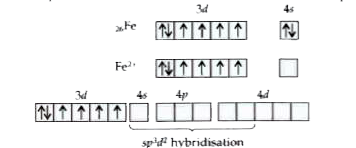What can be inferred from the magnetic moment values of the following complex species ?
ExampleMagnetic moment (BM)K4[Mn(CN)6]2.2[Fe(H2O)6]2+5.3K2[MnCl4]5.9
Magnetic moment (μ)=√n(n+2) BM
When n = 1, μ=√1(1+2)=√3=1.73
When n = 2, μ=√2(2+2)=√8=2.83
When n = 3, μ=√3(3+2)=√15=3.87
When n = 4, μ=√4(4+2)=√24=4.89
When n = 5, μ=√5(5+2)=√35=5.92
(i) K4[Mn(CN)6] : In this complex, Mn is in +2 oxidation state, i.e., as Mn2+.
μ=2.2 BM shows that it has only one unpaired electron. Thus, when strong CN− ligands approach Mn2+ ion, pairing of electrons in 3d orbitals takes place as shown in the figure. The hybridisation involved is d2sp3 forming inner orbital octahedral complex.

(ii) [Fe(H2O)6]2+ : In this complex, Fe is in +2 state, i.e., as Fe2+.
μ=5.3 BM shows that there are four unpaired electrons. This means that the electrons in 3d do not pair up when the ligands, H2O molecules, approach. Thus, H2O is a weak ligand. The hybridisation will be sp3d2. Hence, it will be an outer orbital octahedral complex.

(iii) K2[MnCl4] : In this complex, Mn is in +2 state, i.e., as Mn2+.
μ=5.92 BM shows tthat there are five unpaired electrons. Thus, the hybridisation involved will be sp3 and the complex will be tetrahedral.

Topper's Solved these Questions
- THE D-AND F-BLOCK ELEMENTS Book:U-LIKE SERIESChapter:THE D-AND F-BLOCK ELEMENTS Exercise:CASE BASED/SOURCE-BASED INTEGRATED QUESTIONS
Explore 15 Videos
- THE D-AND F-BLOCK ELEMENTS Book:U-LIKE SERIESChapter:THE D-AND F-BLOCK ELEMENTS Exercise:MULTIPLE CHOICE QUESTIONS
Explore 20 Videos
- THE D-AND F-BLOCK ELEMENTS Book:U-LIKE SERIESChapter:THE D-AND F-BLOCK ELEMENTS Exercise:SELF ASSESSMENT TEST (SECTION A ) MULTIPLE CHOICE QUESTIONS (CHOOSE THE CORRECT OPTION)
Explore 7 Videos
- SURFACE CHEMISTRYBook:U-LIKE SERIESChapter:SURFACE CHEMISTRYExercise:SELF ASSESSMENT TEST ( SECTION A)
Explore 7 Videos
- THE P-BLOCK ELEMENTS Book:U-LIKE SERIESChapter:THE P-BLOCK ELEMENTS Exercise:SELF ASSESSMENT TEST ( SECTION A)
Explore 7 Videos
Similar Questions
What can be inferred from the magnetic moment values of the following complex species?
ExampleMagnetic moment(BM)K4[Mn(CN)6]2.2[Fe(H2O)6]2+5.3K2[MnCl4]5.9
View SolutionWhat can be inferred from the magnetic moment values of the following complex species ?(Example,Magnetic,(BM)),(K4[Mn(CN)6),2.2),([Fe(H2O)6]2+,5.3),(K2[MnCl4],5.9)
View Solution
Knowledge Check
The magnetic moment of the complex [Ti(H2O)6]3+ is
A3.87BMB1.73BMC2.84BMD5.87BMAmong the following complexes , which has a magnetic moment of 5.9 BM
Ni(CO)4[Fe(H2O)6]2+,[Co(NH3)6]3+,[mnBr4]2−,[Zn(NH3)4]2+ANi(CO)4B[Fe(H2O)6]2+C[Co(NH3)6]3+D[MnBr4]2−
What can be inferred from the magnetic moment values of the following complex species ?(Example,Magnetic,(BM)),(K4[Mn(CN)6),2.2),([Fe(H2O)6]2+,5.3),(K2[MnCl4],5.9)
View SolutionWhat can be inferred from the magnetic moment values of the following camplex species?
ExampleMagneticMoment(BM)K4[Mn(CN)6]2.2[Fe(H2O)6]5.3K2(MnCl4]5.9
View SolutionCalculate magnetic moment of Fe3+ in [Fe(CN)6]3+ and in [Fe(H2O)6]3+
View SolutionArrange the following complexes in decreasing orger of magnetic moment:
[Ni(H2O)4]2+,[Ni(CN)4]2−,[Fe(CN)6]3−,[Fe(CN)6]4−
View SolutionArrange the following complexes in decreasing orger of magnetic moment:
[Ni(H2O)4]2+,[Ni(CN)4]2−,[Fe(CN)6]3−,[Fe(CN)6]4−
View SolutionThe spin magnetic moment of iron in K3[Fe(CN)6]
View Solution

